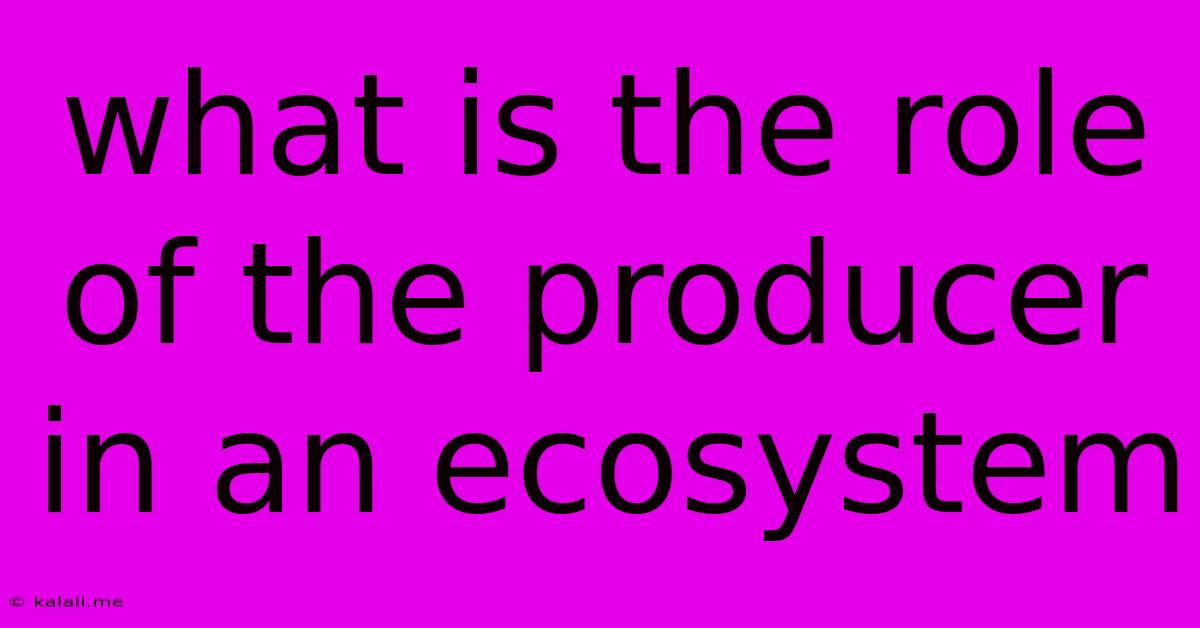What Is The Role Of The Producer In An Ecosystem
Kalali
May 10, 2025 · 3 min read

Table of Contents
The Unsung Hero of the Ecosystem: Understanding the Producer's Role
The vibrant tapestry of life on Earth depends on a complex interplay of organisms, each fulfilling a specific role within the intricate web of the ecosystem. While predators and decomposers often capture the imagination, the foundation of this entire structure rests upon the often-unsung heroes: the producers. This article will delve into the crucial role of producers in an ecosystem, exploring their vital functions and the consequences of their absence. Understanding their significance is key to comprehending the delicate balance of nature and the importance of biodiversity.
Producers, also known as autotrophs, are organisms capable of producing their own food using inorganic sources. This process, primarily photosynthesis, forms the very base of most food chains and webs. Without producers, the entire ecosystem would collapse, leaving no energy source to support the rest of the biological community.
The Cornerstone of Energy Flow: Photosynthesis and Chemosynthesis
The primary method used by producers is photosynthesis, where sunlight fuels the conversion of carbon dioxide and water into glucose (a sugar) and oxygen. This glucose serves as the primary source of energy for the producer and subsequently for the entire ecosystem. Plants, algae, and cyanobacteria are prime examples of photosynthetic producers.
In environments lacking sunlight, such as deep-sea hydrothermal vents, some producers utilize chemosynthesis. This process converts chemical energy from inorganic compounds like hydrogen sulfide into organic matter. Chemosynthetic producers, like certain bacteria, form the base of unique ecosystems in these extreme environments.
Producers as the Foundation of the Food Web
The organic matter produced by producers represents the primary source of energy for all other organisms in the ecosystem. Herbivores, or primary consumers, directly feed on producers, acquiring the energy stored within their tissues. These herbivores are then consumed by carnivores, or secondary consumers, and so on, creating a complex food web. Even decomposers, breaking down dead organic matter, ultimately rely on the initial energy produced by producers.
Beyond Energy: The Importance of Oxygen Production and Habitat Provision
The role of producers extends beyond just providing energy. Photosynthetic producers release oxygen as a byproduct of photosynthesis, a vital gas for the respiration of most organisms. They also provide habitat for countless species, offering shelter, nesting sites, and breeding grounds. Forests, coral reefs, and kelp forests are excellent examples of ecosystems heavily reliant on the habitat provided by producers.
Threats to Producers and Ecosystem Consequences
The health and abundance of producers are vital indicators of ecosystem health. Threats such as deforestation, ocean acidification, pollution, and climate change significantly impact producer populations. A decline in producers can trigger a cascade effect, leading to decreased biodiversity, reduced energy flow, and ultimately, ecosystem collapse.
Examples of Producers Across Diverse Ecosystems
Producers are incredibly diverse, adapting to a wide range of environments. Here are a few examples:
- Terrestrial Ecosystems: Trees, grasses, flowering plants, mosses
- Aquatic Ecosystems: Phytoplankton, algae, seagrasses, kelp
- Extreme Environments: Chemosynthetic bacteria near hydrothermal vents
In conclusion, producers play a fundamental and irreplaceable role in any ecosystem. Their ability to convert inorganic matter into usable energy forms the very foundation of all food webs, supporting the intricate balance of life on Earth. Protecting and preserving these crucial organisms is paramount to maintaining healthy and thriving ecosystems for generations to come.
Latest Posts
Latest Posts
-
How Many Formula Fields Can Be Created Per Object Salesforce
Jun 01, 2025
-
Moment Of Inertia Of A Solid Sphere
Jun 01, 2025
-
What Size Wire For 24000 Btu Mini Split
Jun 01, 2025
-
Hot Water Only Lasts 10 Minutes
Jun 01, 2025
-
Can You Take Glass On A Plane
Jun 01, 2025
Related Post
Thank you for visiting our website which covers about What Is The Role Of The Producer In An Ecosystem . We hope the information provided has been useful to you. Feel free to contact us if you have any questions or need further assistance. See you next time and don't miss to bookmark.